How to two-hand tap like Eddie Van Halen
This hands-on and tabbed lesson offers a comprehensive primer in Eddie's signature lead style, as well as a brief history of two-hand tapping itself
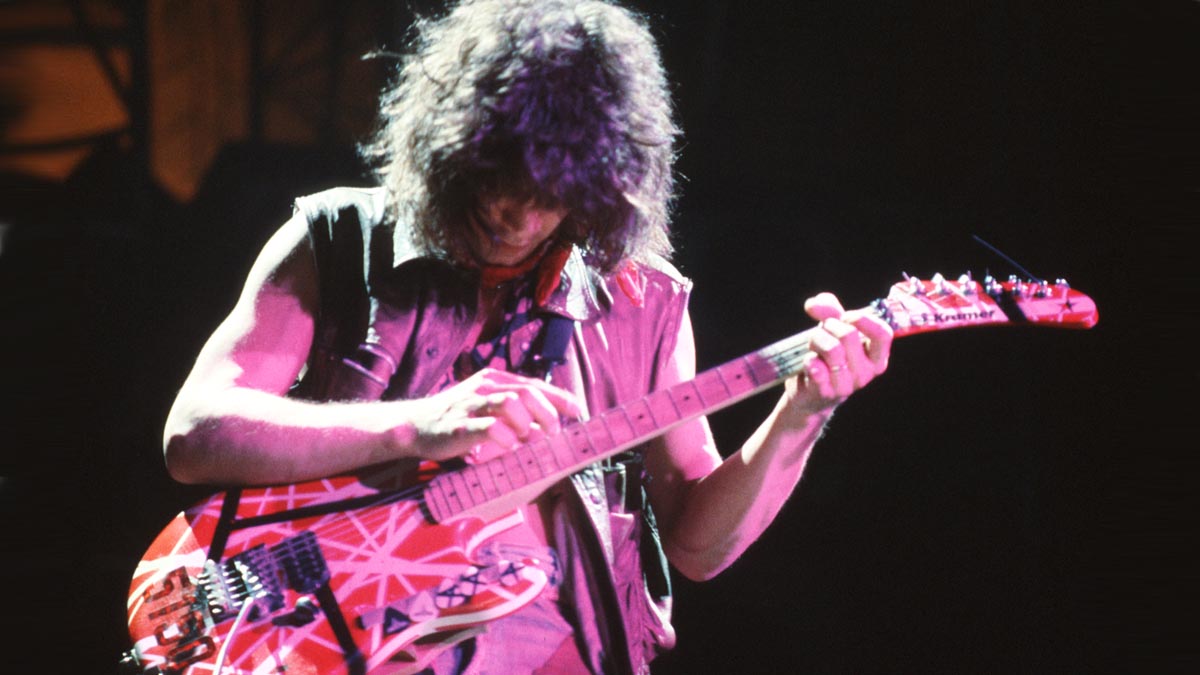
Of all the things that remain most important to guitar players, such as being able to write cool, catchy riffs, solo with great feeling and being able to play perfectly in tune all the time, there’s one desire that allures many rock players especially – speed.
Just like the first time you stole your parents’ car, there is for most players a certain thrill and exhilaration to playing fast licks. For these guitarists, one surefire way to achieve steadily continuous note production at high velocity is to use fretboard tapping.
Tapping allows a guitarist not only to play musical phrases rapidly but also to cover much wider areas of the fretboard than could possibly be reached with just the fretting hand
Fretboard tapping is a technique for which both hands are used to independently sound different notes on the instrument. In fretboard tapping, a pick-hand finger sounds a note by tapping the fretboard on a specific string and fret.
This technique allows a guitarist not only to play musical phrases rapidly but also to cover much wider areas of the fretboard than could possibly be reached with just the fretting hand. During the late Seventies, Eddie Van Halen blasted out of Southern California with an explosive sound that blew everyone away.
His show-stopping solo masterpiece, Eruption, recorded for the debut Van Halen album, featured long passages of fretboard tapping. Virtually overnight, Eddie was a star and fretboard tapping became de rigueur for aspiring shredmeisters.
In truth, fretboard tapping techniques can be traced back to earlier centuries: violin virtuoso Niccolo Paganini used similar techniques on the violin during the early 1800s, and a tapping-like technique known as selpe was used in traditional Turkish folk music.
Examples of the tapping on electric guitar can be found throughout the 20th century, such as late-'60s guitarist Randy Resnick’s attempt to approximate saxophone great John Coltrane’s “sheets of sound” in his work with John Mayall, jazz/rock pioneer Harvey Mandel’s employment of the technique on many of his records, and avant garde genius Frank Zappa’s tapping with the edge of the pick during his solo in Inca Roads (One Size Fits All, 1975).
Let us also not forget Steve Hackett, Roy Smeck, Dave Bunker (check out Dave Bunker on Ozark Jubilee Circa 1960 below) and Vittorio Camardese, whose circa-1965 two-hand tapping caused quite a stir when we shared a video on GuitarWorld back in 2013. (Be sure to Google “Amateur Guitarist Vittorio Camardese Displays Two-Handed Tapping Technique in 1965.”)
In 1969, Emmett Chapman invented the Chapman Stick, an instrument intended to be played by pressing the strings down to a fretboard using the fingers of both hands. But, since the arrival of Eddie Van Halen in the late Seventies, fretboard tapping has been most widely associated with hard rock and metal.
Randy Rhoads is another guitarist from the late-'70s/early-'80s metal era that, like Eddie, took fretboard tapping into new dimensions.
By the mid-'80s, tapping had evolved even further at the hands of guitarists such as Joe Satriani, Steve Vai, Paul Gilbert, Jeff Watson (who tapped with four fingers of his pick hand) and jazz/fusion wizard Allan Holdsworth, among many others, and it remains prevalent today.
Tapping Basics
Let's begin with the simplest tapping technique of all: applying a single tap with the pick hand. As illustrated in Figure 1a, use the tip of one of your pick-hand fingers – most players use either their index or middle finger – and tap the high E string at the 12th fret in order to sound a high E note.
To produce an audible tone, the tap should be firm and, just like a hammer-on, land behind the fret (to the left of it, if you’re a right-handed player). Keep the tapping finger pressed against the string and fretboard so that the note continues to ring.
Whichever finger you choose to tap with, I recommend resting your pick hand’s thumb on the top side of the guitar neck (near the low E string) in order to provide some stability and a tactile point of reference for the hand while tapping.
Doing this also enables you to palm to mute the lower strings to prevent them from ringing sympathetically as you tap. As regards what to do with the pick, you have three options: 1) continue to hold it, 2) tuck it into your palm, or 3) let go of it temporarily, by either putting it down or clasping it between your lips (seriously).
When releasing the tapped note, the finger should flick the string slightly sideways, either in a downward or upward direction, so as to pluck the string slightly as the tapping finger releases it. This technique essentially accomplishes the same thing as a fret-hand pull-off, which is to keep the string vibrating by yanking it slightly sideways before releasing it.

The best way to get started with this technique is to tap your pick hand’s 1st or 2nd finger onto the high E string at the 12th fret, push-off (or pull-off) in order to sound the open E note, then repeat the sequence in a continuous loop, gradually increasing speed, as illustrated in Figure 1a.
The next step is to try doing the same thing on the other five strings. As shown in Figure 1b, begin by tapping and pushing off twice to sound four 16th notes on beat 1, repeat this four-note sequence three more times for beats 2 through 4, then move the process over to the next lower string.
Adding One Note to Form Triplets
Now that you've gotten a handle on the basic tapping technique, let’s add one note with the fret hand in order to sound a three-note combination known as a triplet, which is the most common melodic “shape” used when tapping.
After tapping and pushing-off (or pulling-off) to the open string, we’re going to hammer a fingertip from the fret hand down onto the string in a movement similar to the pick-hand tap.
As shown in Figure 2a, start with a tap at the 12th fret on the high E string, push- or pull-off to sound the open E note, and then hammer the tip of your fret hand’s index finger onto the string at the 7th fret, sounding a B note. These three notes together comprise an eighth-note triplet.
Repeat the process with another tap, push/pull-off and hammer-on, and proceed to chain together the three notes into a continuous, unbroken loop while gradually increasing speed. The goal is to make all the notes sound at the same volume, and you’ll need to listen critically as you play, to determine if you’re tapping and hammering with sufficient force and pushing/pulling-off correctly.
Like Figure 1b, Figure 2b has you moving this pattern over to all of the other strings. Once you feel comfortable with this technique and can execute it cleanly, ramp up the speed. Many guitarists like to move quickly between two adjacent strings when performing tapped licks.
In Figure 2c, the tapped triplet quickly alternates between the top two strings. It’s also fun to do this with three strings, as demonstrated in Figure 2d. When you’ve got a handle on moving across the strings in this manner, try inventing some of your own string-crossing patterns.
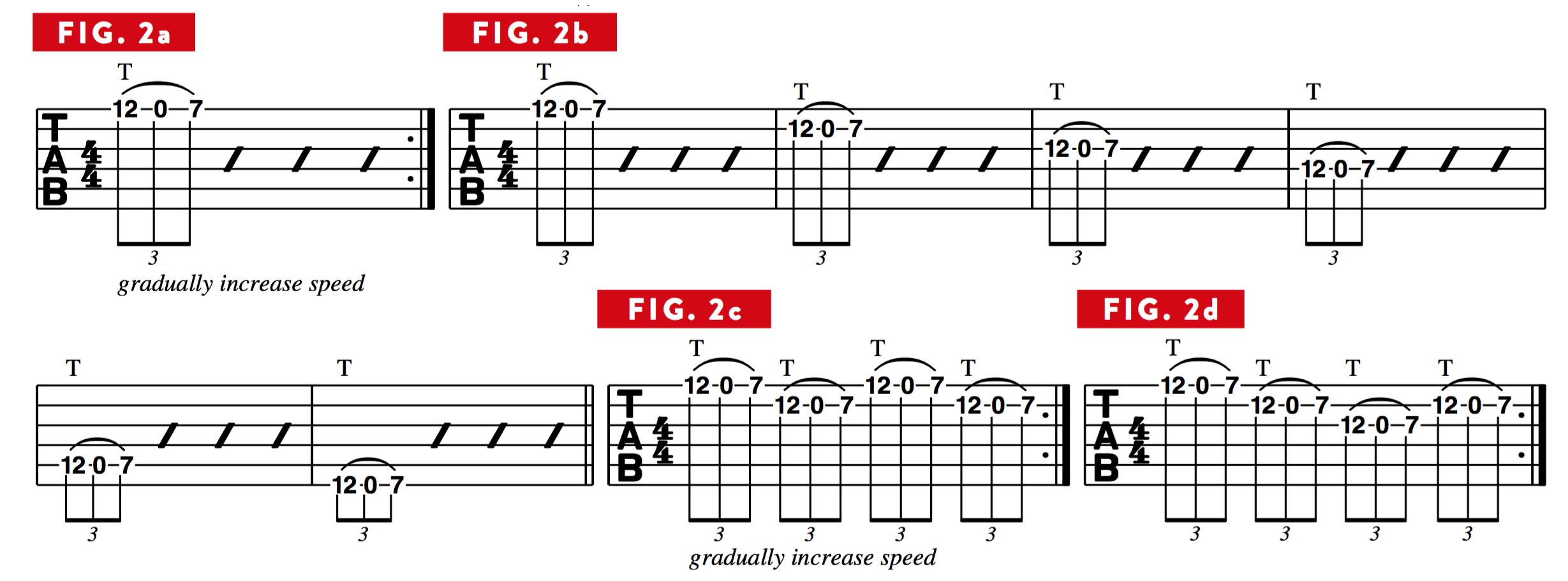
Moving the Fret Hand Around
Now, using the same 12th-fret tapped note, let’s move the fret hand around to different positions in order to create melodic variations. In Figure 3a, I use the tapped note at the 12th fret on the high E string as a pickup in order to start the lick, with the open E string sounded as the first eighth note of the repeated eighth-note triplet.
For the first four triplets, the fret-hand index finger frets a B at the 7th fret. The finger then moves down chromatically to the 4th fret across the next two bars, and then moves back up across the next two bars.
There are an infinite number of melodies that can be created using this technique because, as the tap/pull-off keeps the string ringing, notes sounded with the fret-hand finger can be applied anywhere and in any order.

Many guitarists incorporate minor or major scales with tapping, but let’s first incorporate the chromatic scale, which includes every note within an octave. As shown in Figure 3b, the tapped high E note and subsequent open E are both pickup notes to the downbeat (first note) of bar 1, which is a 12th-fret high E, sounded with a fret-hand hammer-on.
When alternately tapping and hammering at the same fret like this, you’ll need to make sure each finger quickly gets out of the other one’s way, so that they don’t bump into each other.
This triplet is played four times, after which the fret-hand note moves down to the 11th fret in bar 2 and proceeds to descend one fret at a time in each subsequent bar. Once you feel you can play this phrase comfortably, try moving it over to the other strings.
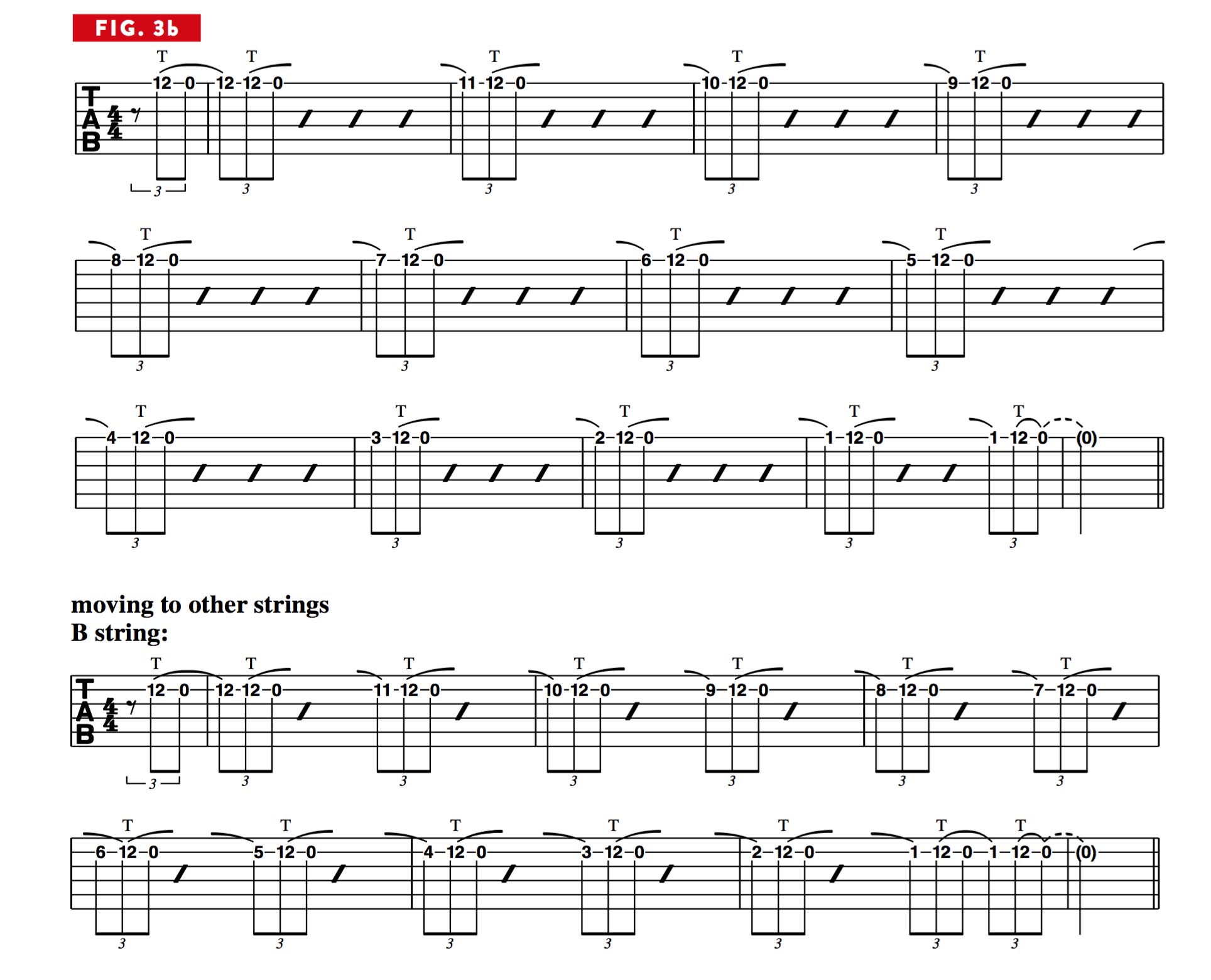
Employing Scales
Using scales as the basis for tapped figures is a technique employed greatly by guitarists such as Eddie Van Halen, Randy Rhoads, Steve Vai, Joe Satriani and many others, so let’s bring a commonly used minor scale into the mix: Figure 4a illustrates the E Aeolian mode (E, F#, G, A, B, C, D), also known as the E natural minor scale, as it is played across two octaves on the high E string.
Figure 4b illustrates a descending/ascending tapped lick based on this scale, played in 43 meter.
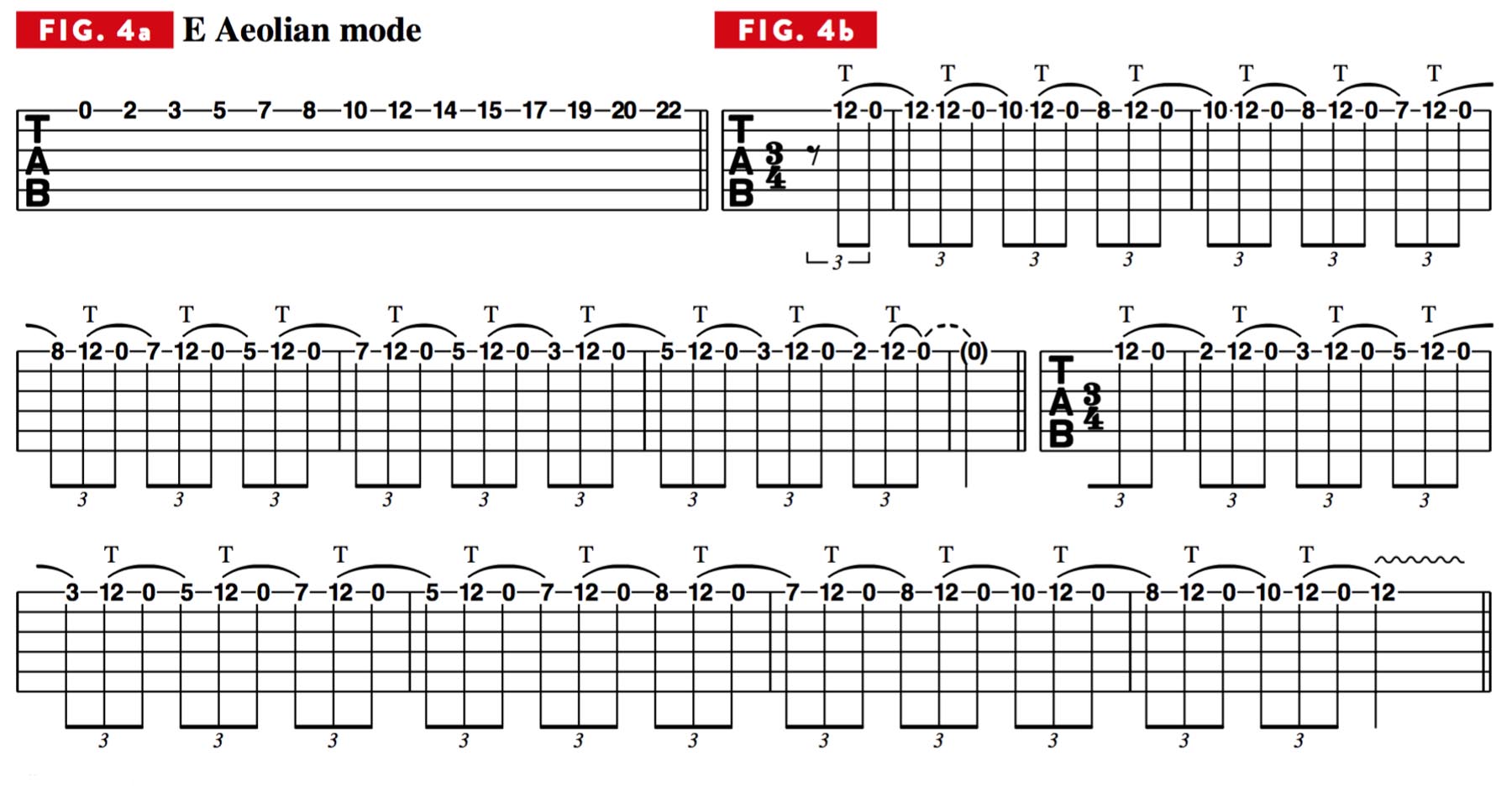
When playing tapped figures like these, you can create an effect that’s both musically and visually cool by crossing hands, as demonstrated in Figure 4c.
In bar 5 of this example, the fret hand hammers notes that are higher up the neck than the tapping finger and remains higher on the fretboard through bar 12. In the last bar, the fret hand crosses back and forth.
Crossing hands is a great way to find more freedom and options for formulating tapped melodic ideas. If we move this idea over to the other strings, we would sound the Aeolian mode (natural minor scale) in the key dictated by the open string.
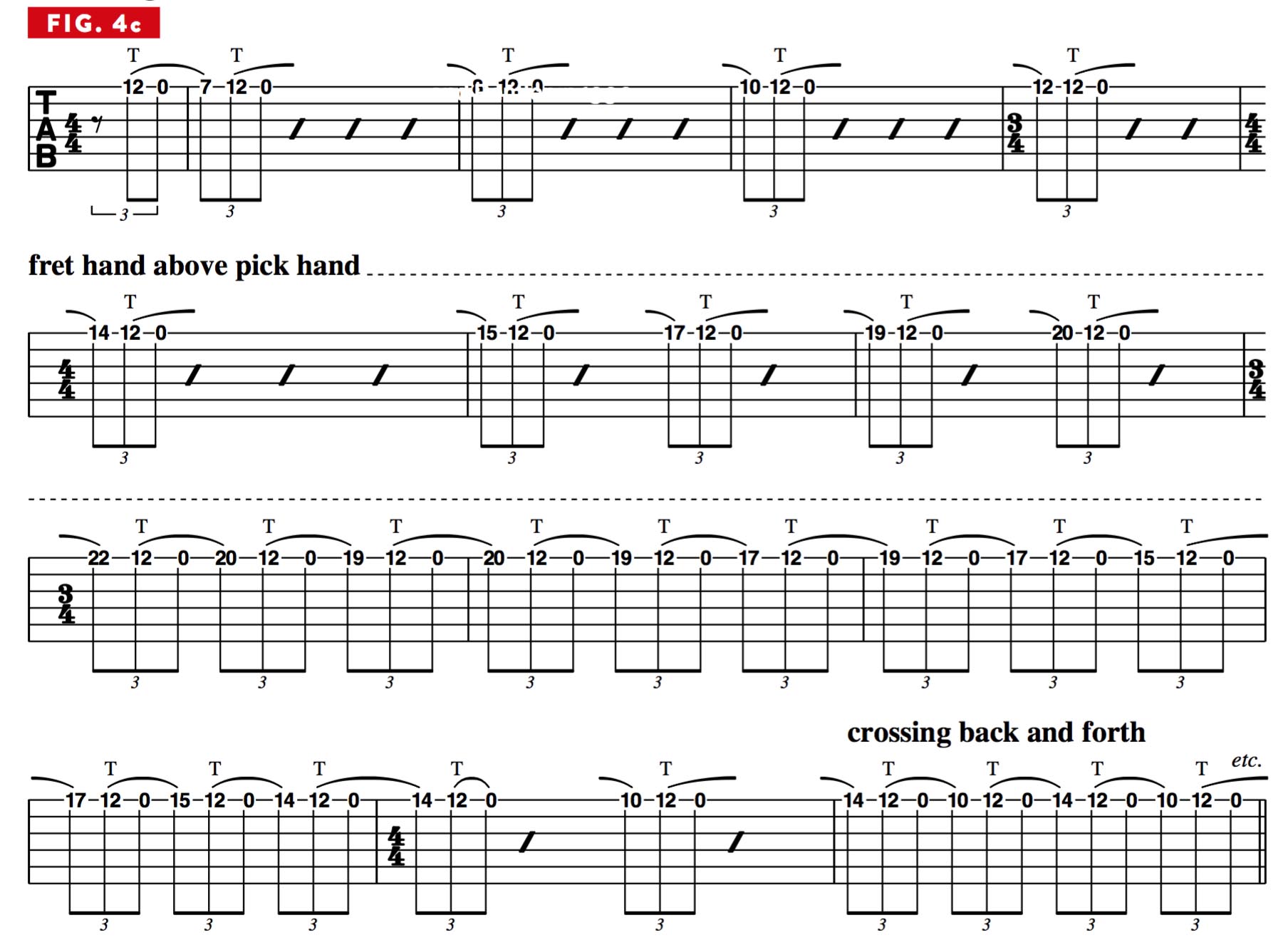
Figure 5a illustrates this concept as applied to the B string, sounding B Aeolian (B, C#, D, E, F#, G, A), and Figure 5b illustrates the Figure 4b lick as it would be performed on the B string, followed by some cross-hand melodies.
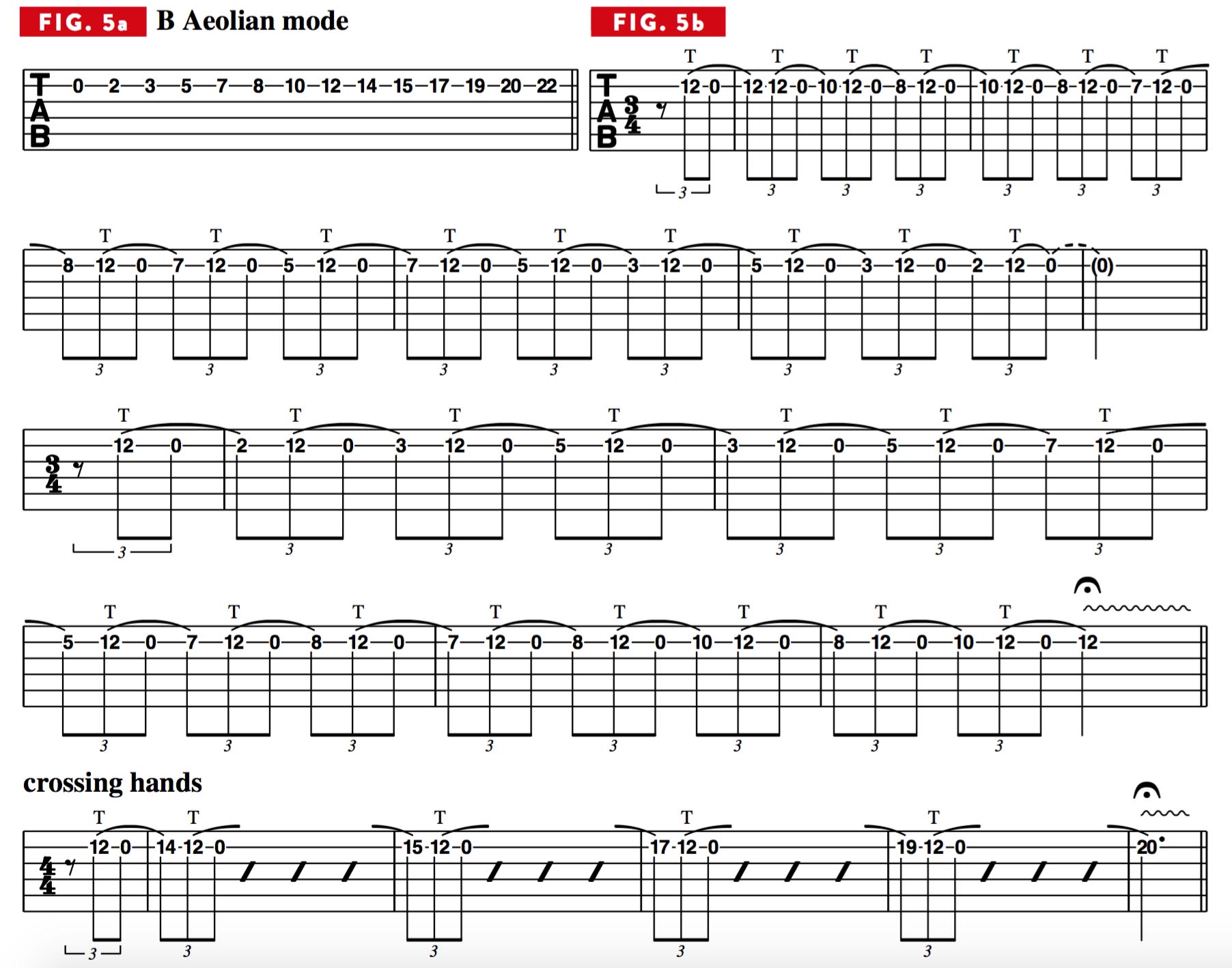
Figure 5c shows the technique performed on the G string; continue the process across all of the strings.

Tapping 3rds Apart
Let's now elaborate on the scalar approach. Using E Aeolian, Figure 6a shows a lick wherein pairs of fret-hand notes are sounded three scale degrees, or 3rds, apart, and then the pair descends the fretboard while remaining diatonic to (within the scale structure of ) E Aeolian.
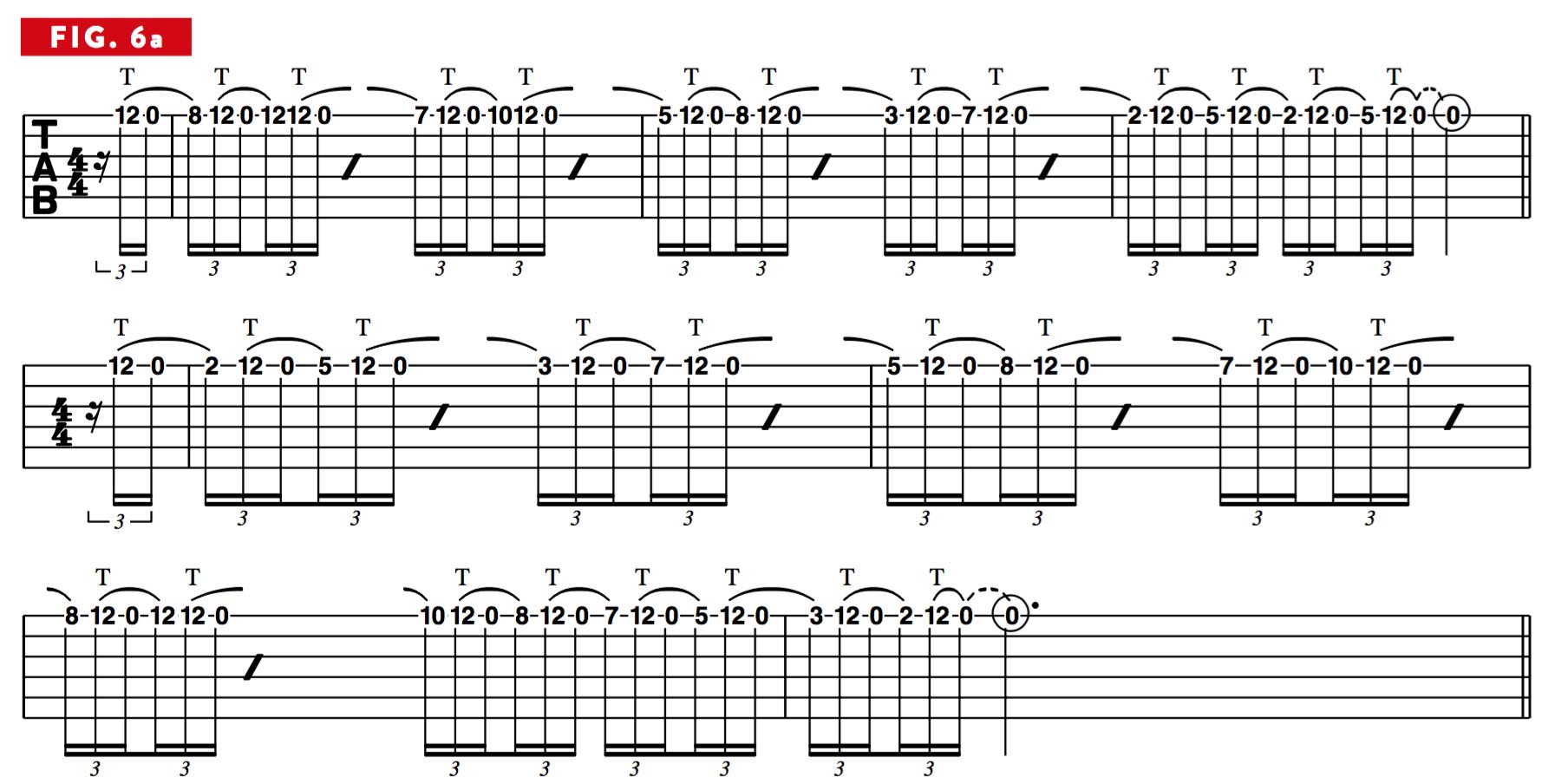
The sound of this tapped figure is more arpeggio-like because each three-note melodic shape alludes to a different chord. If we move this pattern over to the B string, the result is a phrase based on B Aeolian, as shown in Figure 6b.

Using Only Fretted Notes
Another commonly used tapping technique is to forgo the use of open strings and use only fretted, or “closed” notes. Previously, we created triplets with the combination of one tapped note, an open string and a fret-hand hammer-on. Now we’ll go directly from tapped notes to fretted notes.
In Figure 7a, the fret hand sounds the pitches of E Aeolian on the high E string, ascending and descending, while the pick hand repeatedly taps at the 12th fret. The initial 12th-fret tap in this example is a pickup note that’s pushed/pulled off on the downbeat of the first bar to F# at the 2nd fret. In this lick, the listener’s attention is drawn to the constantly changing fret-hand notes.
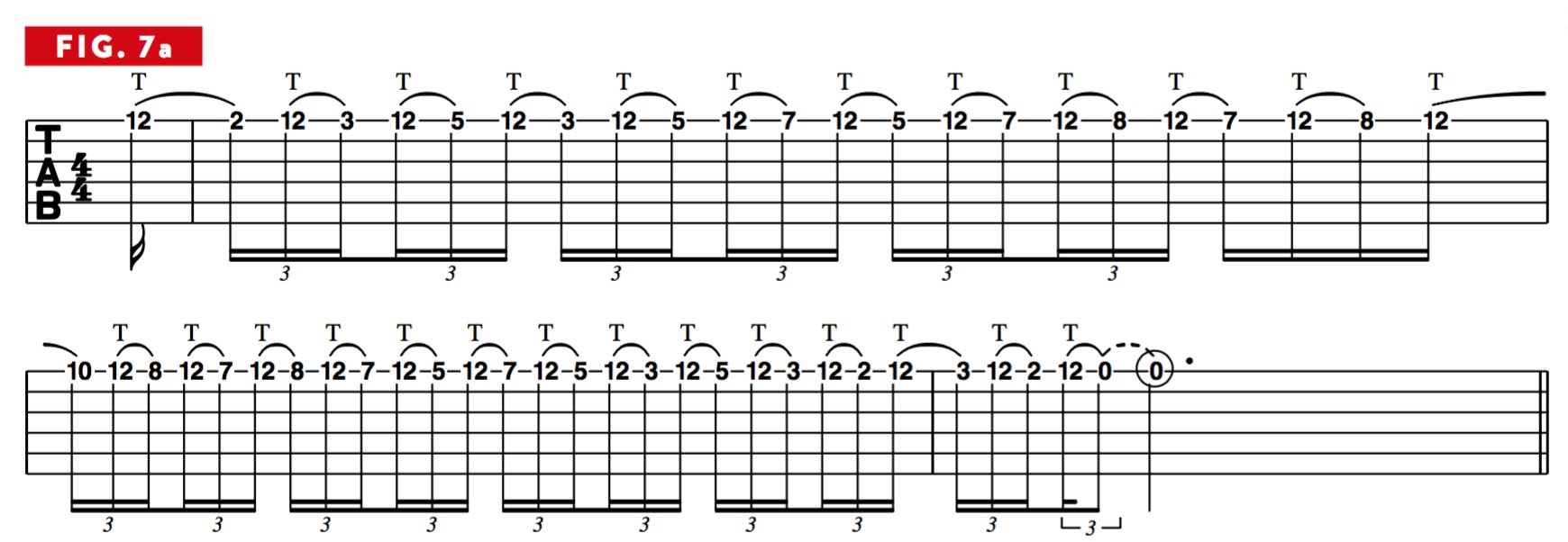
In Figure 7b, the phrase is moved over to the B string. Try playing it on the remaining strings.

Symmetrical Shapes
Another favorite tapping technique among shredders involves the use of chromatically ascending or descending symmetrical shapes formed with the fret hand.
In the first bar of Figure 8a, the fret hand sounds notes that are three frets apart on the high E string, with a 12th-fret tap and a push/pull-off to the open string between each fret-hand note.
Beginning at the 4th and 7th frets, the pair is moved one fret higher in bar 2 to the 5th and 8th frets, and then the ascending pattern continues through the next two bars, after which the shape descends in a similar fashion.

Figure 8b illustrates the same pattern performed on the B string.

Moving the Pick Hand Around
For all of the licks demonstrated thus far, the pick hand has tapped at the same place – the 12th fret – while the fret hand has moved around. Now let’s move the tapped note around while keeping the fret-hand note in the same location.
In Figure 9, the tapping hand ascends the E Aeolian mode on the high E string with an open E note and a 7th-fret hammer-on sandwiched between each tapped note.
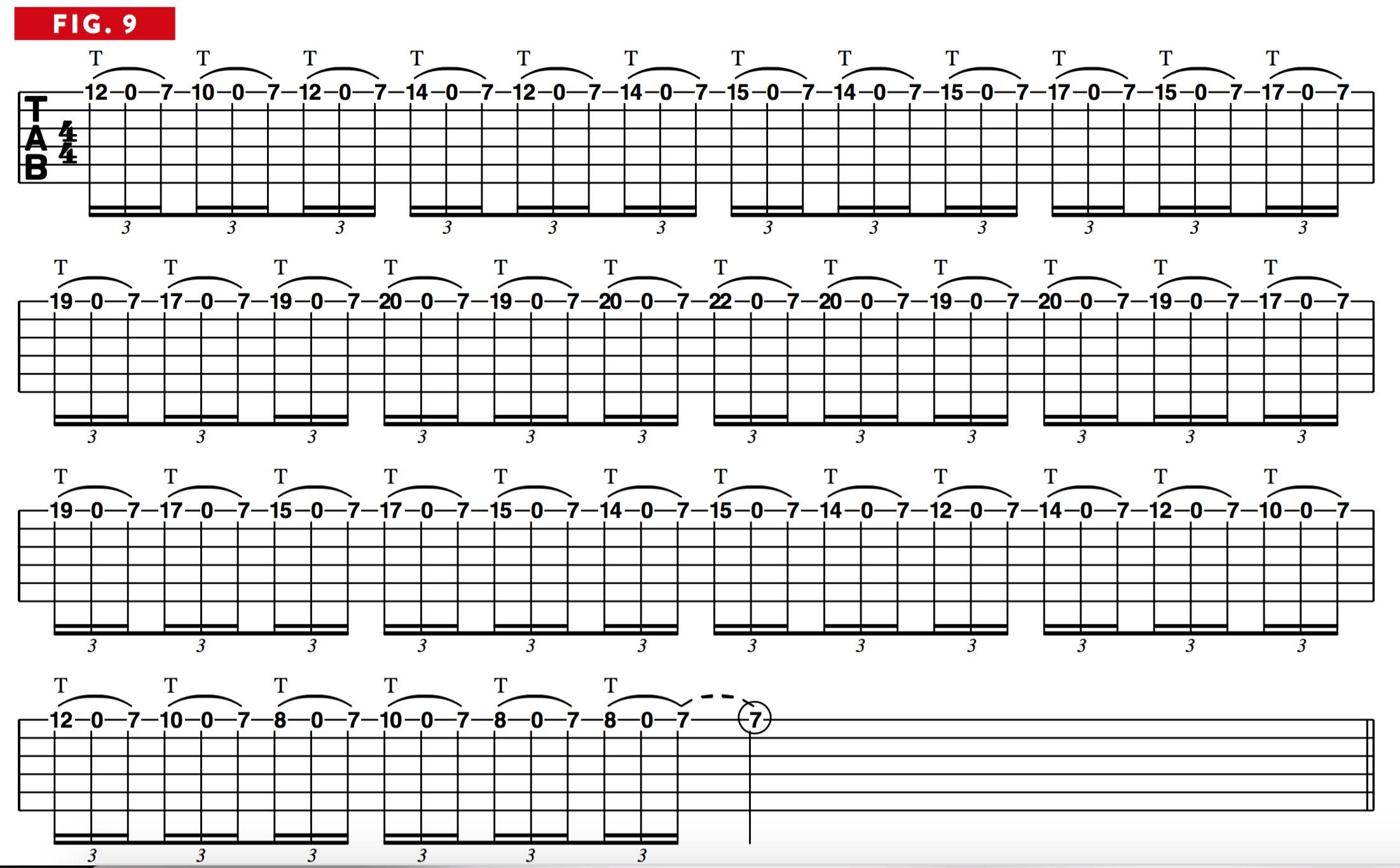
You can also try crossing hands with this technique, as demonstrated in Figure 10. In this lick, both hands push- or pull-off to the open E string, which creates a cool rhythmic effect.

Two Notes with the Fret Hand
The most commonly used tapping pattern – one that’s featured prominently in Eddie Van Halen’s Eruption and Spanish Fly – is a triplet wherein a single tapped note is played in conjunction with two fretted notes to form an arpeggio.
Very often, the three-note shapes outline either a major or minor triad; which consists of the root, 3rd and 5th of a given scale.
Figure 11a shows the notes of an E major triad played on the high E string: E is the root note, G# is the major 3rd, and B is the 5th. In the next bar, the high E note at the 12th fret is tapped as a pickup note and then pushed/pulled-off to the fret-hand index finger, positioned at the 4th fret.
The fret-hand pinkie then hammers on to the 7th fret, after which the tap is reapplied at the 12th fret to complete the eighth-note triplet, then the sequence repeats.

This phrase can be started with either a conventional tap at the 12th fret or by employing a technique known as a silent tap/pull-off.
As shown in Figure 11b, gently place the tip of the tapping finger on the string at the 12th fret without depressing the string to the fretboard, then push- or pull-off with the tip of the finger, in effect plucking the string in order to initiate its vibration.
This gets the string ringing, and then the rest of the notes are sounded as before. As you move this pattern over to the other strings, you will sound major triads that correlate with each string, as shown in Figure 11c.
Play each triad on each string individually and then in a repeating manner. When moving to the next lower string, notice that the tapping finger must arrive there first, in order to do the silent tap/pull-off before the fret-hand fingers follow suit.

Also, moving across the strings in this way alludes to an inherent chord progression, one that is based on each of the open strings and moves from high to low: E, B, G, D, A, E. Eddie Van Halen used triad-based tapped figures in many songs to imply chord progressions.
16th-Note Figures
If we reincorporate open strings into these tapped three-note shapes, we get four-note figures that can be sounded as flowing streams of 16th notes. Figure 12a illustrates this procedure, and Figure 12b demonstrates the technique as it is moved across all six strings.
Notice that the fret hand does two pull-offs in succession, with the pinkie pulling-off to the index finger, which then pulls-off to the open string. This move is known as a double pull-off.
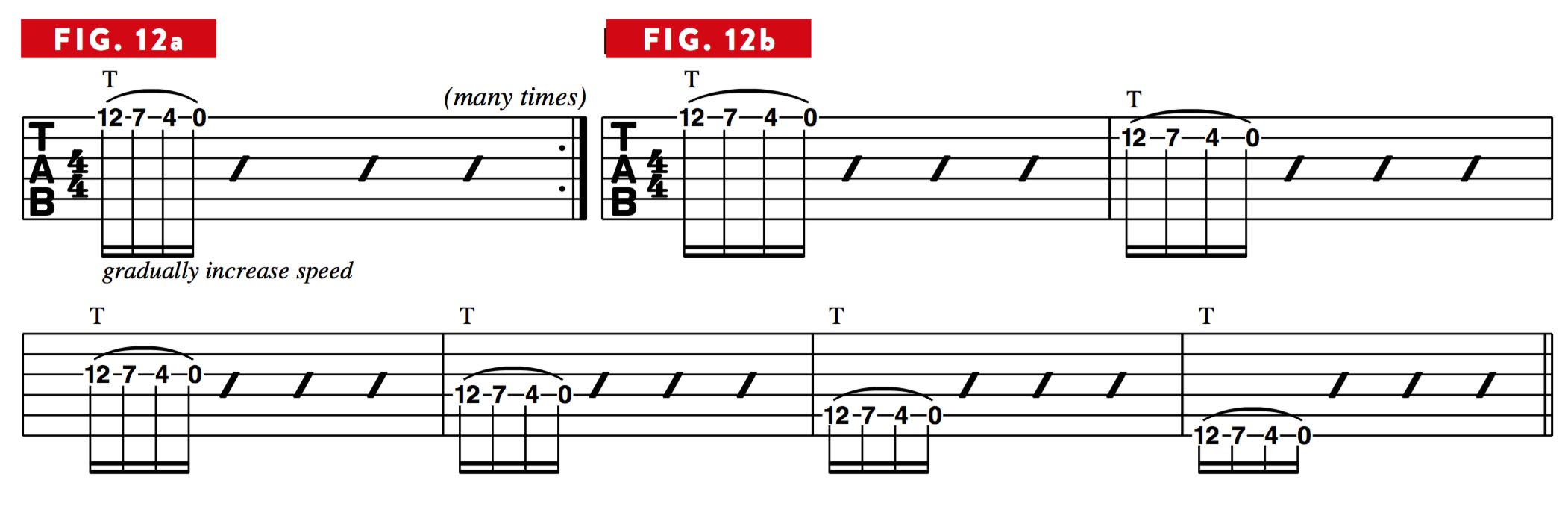
Sextuplets
In our previous example, each 16th-note shape ends with the open string. If we rearticulate the two fret-hand notes by hammering back onto them from the open string, we get a six-note figure, or sextuplet, as shown in bar 1 of Figure 13a.
The first four notes of this six-note pattern are played just like the first four notes of Figure 12a, but here the fret hand goes on to perform a double hammer-on, from the open string to the 4th fret, then the 7th, executed with the index finger and pinkie.
The six notes fall evenly within a single beat, and the pattern repeats many times. Once you get the sequence under your fingers and can play it quickly and cleanly, try moving the shape over to each lower string, as demonstrated in Figure 13b.
Eddie Van Halen used these types of sextuplets, albeit based on minor triads, for the intro to the Van Halen classic, Hot for Teacher.

Descending and Ascending Triplets
Another tapping technique that was favored by Van Halen – one that can be heard on tracks like Eruption and The Cradle Will Rock – is the use of descending and ascending triplets.
In Figure 14a, a single tapped note is followed by two fretted notes and is played as two 16th-note triplets, which together are metrically equal to a sextuplet. The fret-hand index finger and pinkie fret the 7th and 10th frets, respectively, and then move down chromatically to 4th position.
In the first ending, the riff moves back up; in the second ending, it continues downward, culminating in 2nd position. Figure 14b shows the same idea on the B string.
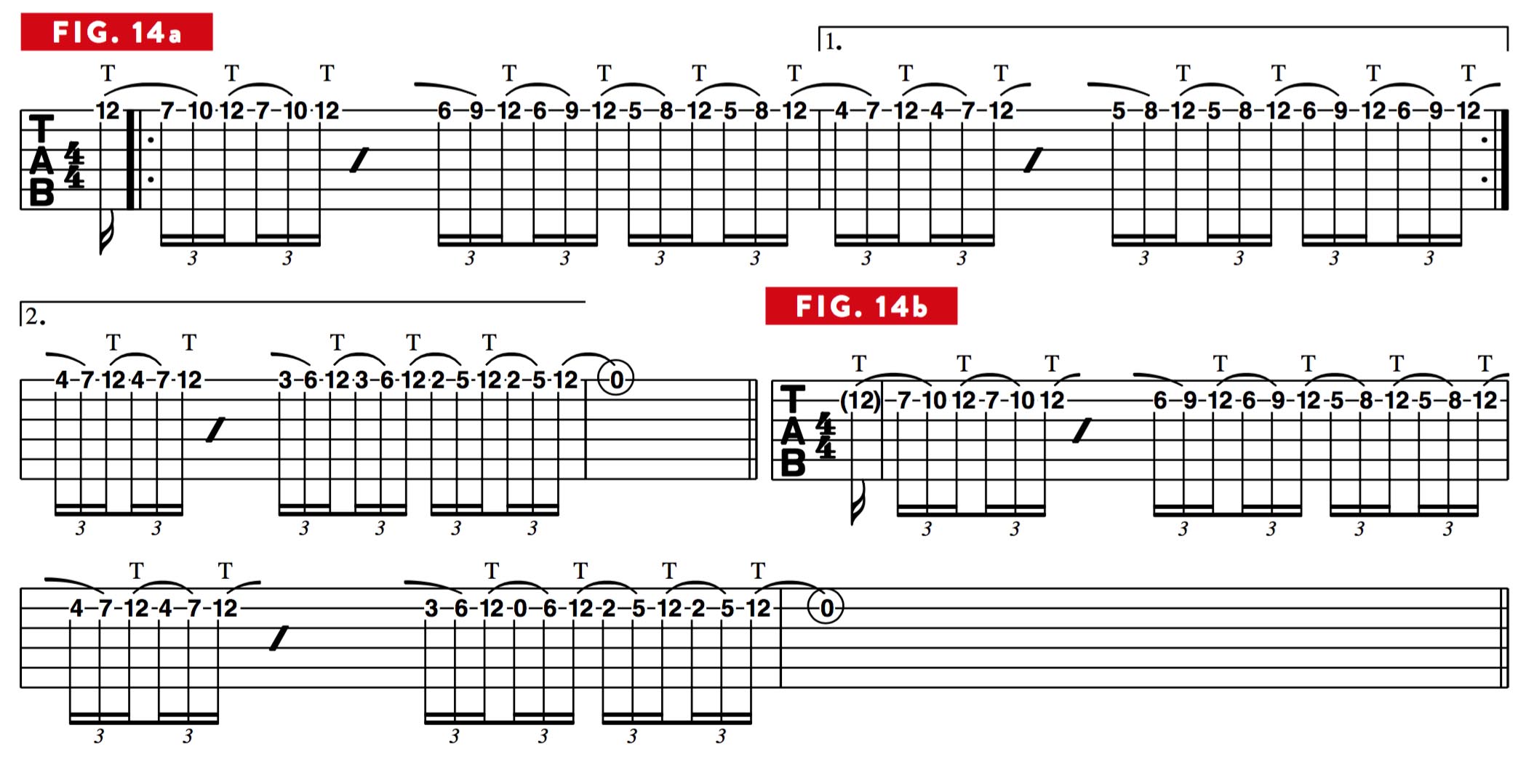
Tapped Bends
Tapped bends are performed with essentially the same technique as a conventional tapped lick, except the fret hand incorporates bends into the melodic ideas. When a string is bent, tapping at a given fret will logically sound a higher pitch than when tapping onto an unbent string.
Figure 15a shows the first five notes of the A Aeolian mode (A, B, C, D, E, F, G) tapped on the G string, beginning at the 14th fret. If you were to bend the G string up one whole step with your fret hand, a tapped A note will be found at the 12th fret, two frets (or one whole step) below its normal location, at the 14th fret.
Likewise, tapping at the 14th fret will now yield a B note, one whole step higher than normal. As shown in bar 2 of FIGURE 15a, all of the notes of A Aeolian are shifted down two frets when tapped onto a string that is bent up one whole step with the fret hand.

The use of tapped bends was a staple of Van Halen’s guitar solo spotlight for many years, and the riff in Figure 15b is based on a long series of tapped bends along the lines of the types of licks he liked to play with this technique.
At the end of the lick, a tap is applied at the 12th fret while the string is bent, then the string is slowly released, or unbent, while the tap is held, causing the pitch of the tapped note to drop, after which the tap is released and the fret hand finishes the lick with pull-offs.

Another cool technique is to utilize the notes of the A blues scale (A, C, D, Eb, E, G) in conjunction with those of the A Aeolian mode, as demonstrated in Figure 15c.

Aside from the fact that playing tapped licks on a low, wound string sounds especially good, I end the phrase by bending the string up a half step, from C to C#, and while holding the bend, I tap at the 11th fret, sounding a high A, which is normally fretted one fret higher, at the 12th fret.
Alternating Between Two Strings
Now let's try moving quickly between the top two strings while applying tapped notes that ascend and descend the fretboard. In Figure 16, three notes are sounded on each string, starting with a tap at the 17th fret that’s followed by a pull-off to the 12th fret and then a hammer-on to the 15th fret.
After this lick is played across beats 1 and 2, the tapped note moves incrementally up the E Aeolian mode as the technique is repeated, after which the tapped note descends in the same manner.
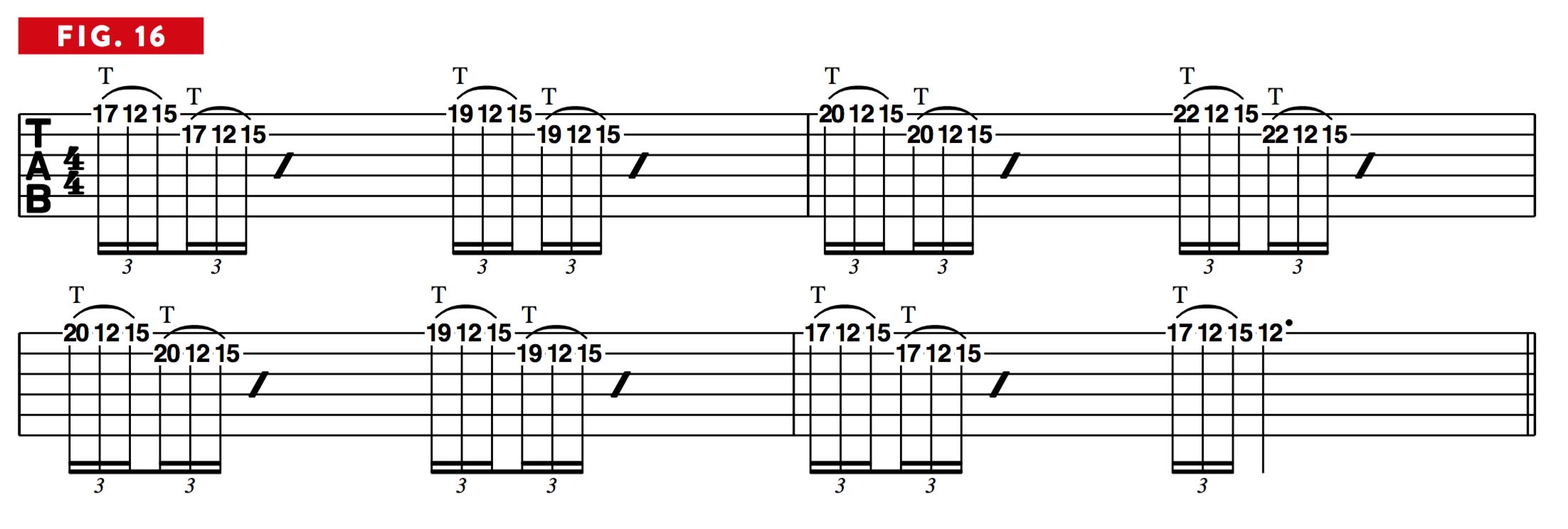
Alternating Among Three Strings
Now let's elaborate on this technique by incorporating three strings. Figure 17a illustrates the A Dorian mode (A, B, C, D, E, F#, G) played in 5th position, and in Figure 17b one tapped note is followed by two fretted notes in the same manner as the previous example, except in this case the three-note figures descend across three strings at a time, starting with the 1st, 2nd and 3rd strings, followed by the 2nd, 3rd and 4th strings, etc.
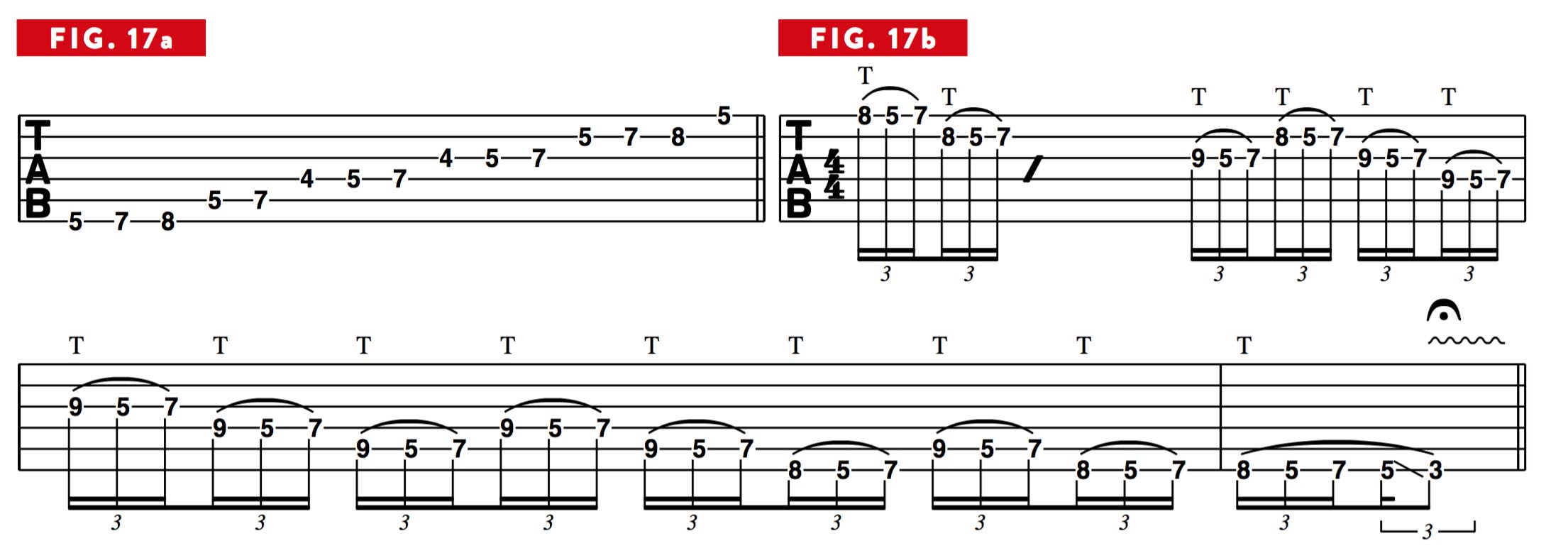
There are countless options available when crossing over three strings at a time, so try coming up with some of your own tapping-across-strings inventions. (Using non-adjacent strings provides a cool twist.)
Three Fretted Notes with One Tapped Note
So far, we've used only two notes with the fret hand within our tapped figures. Now we’re going to add another note to formulate licks made up of three fretted notes plus one tapped note.
In Figure 18, a lick based on the E Dorian mode (E, F#, G, A, B, C#, D) begins with a tapped note followed by a double pull-off to two fretted notes.
The four-note sequence repeats three times, and then the pattern is moved over to the lower strings as the fret positions are altered for the sake of staying within the same mode/scale.
This lick is a bit tricky to play cleanly, so be sure to start out slowly and gradually increase the speed, and do whatever you can to keep unwanted sounds to a minimum!

Okay, now the ball is in your court: take the ideas presented in this lesson and try to come up with as many different inventions and permutations as you can possibly dream up. Fretboard tapping is a technique of unlimited potential, so don’t be afraid to push the limits of possibility.
Get The Pick Newsletter
All the latest guitar news, interviews, lessons, reviews, deals and more, direct to your inbox!
Guitar World Associate Editor Andy Aledort is recognized worldwide for his vast contributions to guitar instruction, via his many best-selling instructional DVDs, transcription books and online lessons. Andy is a regular contributor to Guitar World and Truefire, and has toured with Dickey Betts of the Allman Brothers, as well as participating in several Jimi Hendrix Tribute Tours.









![Joe Bonamassa [left] wears a deep blue suit and polka-dotted shirt and plays his green refin Strat; the late Irish blues legend Rory Gallagher [right] screams and inflicts some punishment on his heavily worn number one Stratocaster.](https://cdn.mos.cms.futurecdn.net/cw28h7UBcTVfTLs7p7eiLe.jpg)

